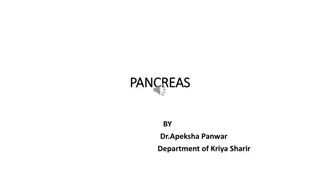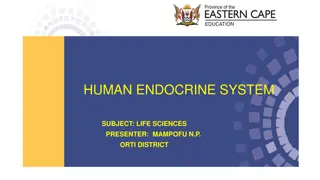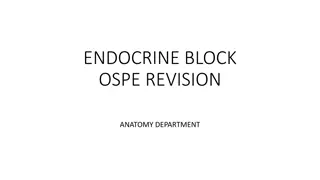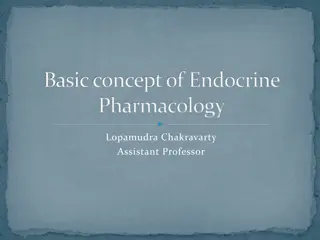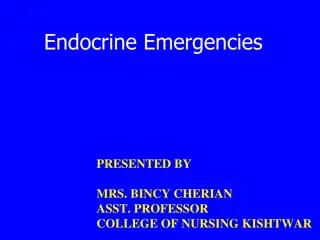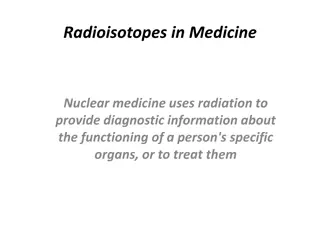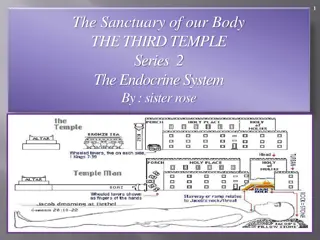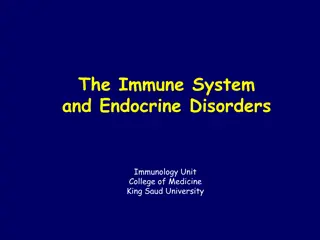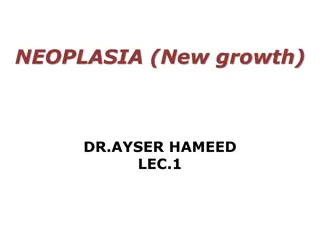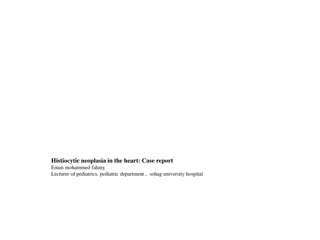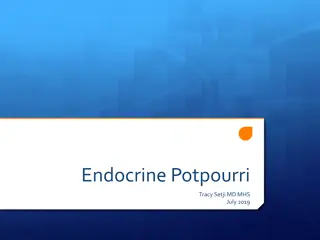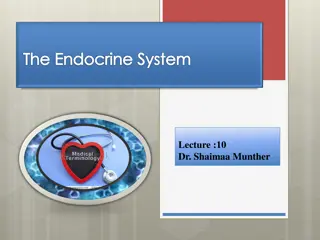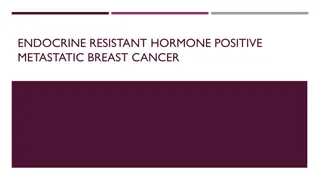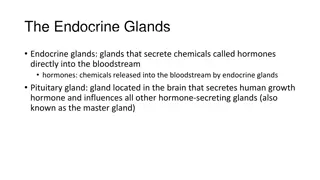Diagnostic Challenges in a 32-Year-Old Woman with Multiple Endocrine Neoplasia 1 (MEN1)
This case study explores the complex presentation of a 32-year-old woman with a history of prolactinoma, amenorrhea, recurrent hypoglycemic attacks, hypercalcemia, elevated PTH, low BMD, fatigue, weakness, adrenal mass, and empty sella syndrome. The agenda includes discussions on MEN1 features, treatment management, insulinoma, hyperparathyroidism, and suggested approaches for mutational analysis and screening. Data on pituitary disease in MEN1 patients are compared, highlighting the prevalence and characteristics of pituitary adenomas in this population. Management outcomes and follow-up data are also discussed.
Download Presentation

Please find below an Image/Link to download the presentation.
The content on the website is provided AS IS for your information and personal use only. It may not be sold, licensed, or shared on other websites without obtaining consent from the author.If you encounter any issues during the download, it is possible that the publisher has removed the file from their server.
You are allowed to download the files provided on this website for personal or commercial use, subject to the condition that they are used lawfully. All files are the property of their respective owners.
The content on the website is provided AS IS for your information and personal use only. It may not be sold, licensed, or shared on other websites without obtaining consent from the author.
E N D
Presentation Transcript
GRAND ROUND 99/3/26
PROBLEM LIST 32y/o woman with: Hx of prolactinoma Amenorrehea Recurrent hypoglycemic attacks Hypercalcemia and elevated PTH and low BMD Fatigue and weakness Adrenal mass Empty sella
AGENDA Empty sella and Apoplexy in MEN1 Adrenal involvement in MEN1 Treatment management in this patient Insulinoma Adrenal mass Hyperparathyroidism Prolactinoma and empty sella Suggested approach for MEN1 mutational analysis in a clinical setting Screening in individuals at high risk of developing MEN1
AGENDA Empty sella and Apoplexy in MEN1 Adrenal involvement in MEN1 Treatment management in this patient Insulinoma Hyperparathyroidism Adrenal mass Prolactinoma and empty sella Suggested approach for MEN1 mutational analysis in a clinical setting Screening in individuals at high risk of developing MEN1
Data on pituitary disease were compared with those from 110 non-MEN1 patients with pituitary adenomas, In our MEN1 series, pituitary disease occurred in 136 of 324 (42%), Mean age of onset of pituitary tumors was 38.0 15.3 yr . 37 of the 136 patients with pituitary disease had concomitantly diagnosis of pituitary adenoma and another endocrine lesion J Clin Endocrinol Metab, February 2002, 87(2):457 465
J Clin Endocrinol Metab, February 2002, 87(2):457 465 MEN1 pituitary adenomas were significantly more frequent in women than in men(50% vs. 31%,P<0.001). Mean age of patients with prolactinomas was significantly younger than that of other types of pituitary adenomas (35.114.8 vs. 43.814.4 yr, P<0.001). Among the 136 pituitary lesions, 19 were microadenomas (14%), and 116 were macroadenomas (85%),
February 2002, 87(2):457465 J Clin Endocrinol Metab, The median follow-up period was 11.4 yr. Normalization of the pituitary hypersecretion occurred, on treatment, in 49 patients (42%), Hypopituitarism developed after treatment in 8 patients (7%). Among the 85 prolactinomas, plasma PRL levels were normalized in only 37 patients (44%).
COMPARISON WITH NON-MEN1 PITUITARY ADENOMAS February 2002, 87(2):457 465 J Clin Endocrinol Metab,
OUTCOME OF PITUITARY ADENOMAS Indeed, we show that prolactinomas in MEN1 are characterized by a larger size but also by a worse response to therapy. Thus, our data suggest that prolactinomas in MEN1 may be more aggressive than those occurring in non- MEN1 patients.
RISK FACTORS OF PITUITARY APOPLEXY Acute increase in hypophyseal blood flow: hypertension or microvascular degeneration, as seen in diabetes, large size of tumor Reduced blood flow to the pituitary tumor: transient increase in intracranial pressure or systemic procedures such as cardiac surgery Hormonal stimulation of the pituitary gland and tumor: pregnancy, the stress response, or exogenous estrogen therapy , active and withdrawal of bromocriptine therapy An anticoagulated state :anticoagulation through drugs or immunodeficiency thrombocytopenia Springer Science+Business Media New York 2014
CNS & Neurological Disorders - Drug Targets, 2012, 11, 1012-1014 Pituitary tumor apoplexy appeared more frequently in macroprolactinomas than in microprolactinomas and also within a year and a half since the beginning of treatment with DA
We were also concluded that apoplexy appears asymptomatic and because of that and because of more frequently appearing in macroprolactinomas, there are recommendations for performing MRI imaging of sellar region more often in patients with macroprolactinomas than in patients with microprolactinomas who are treated with DA. CNS & Neurological Disorders - Drug Targets, 2012, 11, 1012- 1014
AGENDA Empty sella and Apoplexy in MEN1 Adrenal involvement in MEN1 Treatment management in this patient Insulinoma Hyperparathyroidism Adrenal mass Prolactinoma and empty sella Suggested approach for MEN1 mutational analysis in a clinical setting Screening in individuals at high risk of developing MEN1
ADRENAL TUMORS IN MEN1 The incidence : 20% to 55% Most affected patients are asymptomatic, as the majority of tumors, are NF. Indeed, fewer than 10% of patients ,have biochemical evidence of hormonal hypersecretion, Primary hyperaldosteronism and ACTH-independent Cushing syndrome are the most commonly encountered. The occurrence of pheochromocytoma, is rare.
Methods: Analysis of records from 715 MEN1 patients from a multicentre database between 1956 and 2008. Adrenal lesions were compared with those from a multicentre cohort of 144 patients with adrenal sporadic incidentalomas. European Journal of Endocrinology (2012)166 269 279
EUROPEAN JOURNAL OF ENDOCRINOLOGY (2012) 166 ACTH-independent Cushing s syndrome was found in 5.5% of patients with adrenal tumours. Interestingly, Cushing s syndrome was due to a unilateral disease in 3 of the four of our cases with a frank asymmetry in size in favour of the adenoma allowing unilateral adrenalectomy.
No genotypephenotype correlation was evident for the occurrence of adrenal lesions, adrenal tumours and occurrence of endocrine hypersecretion or ACC. Specifically, there was no statistical difference for the occurrence of adrenal lesions between patients with germline mutations in exons 2 and 10 and those with mutations in other exons in the menin gene. European Journal of Endocrinology (2012)166 269 279
Records of follow-up were available for 53 patients with adrenal lesions for a mean duration of 7.4 0.8 (3 72) months. During follow-up, 13 of the 53 patients (24.5%) showed a significant increase in size of the adrenal lesion and two (4%) developed a contralateral lesion of more than 10 mm in size. Ten ACCs occurred in eight patients. Interestingly, ACCs occurred after several years of follow-up of small adrenal tumours in two of the eight affected patients. European Journal of Endocrinology (2012)166 269 279
MEN1 -ASSOCIATED ADRENAL MASS COMPARED TO INCIDENTALOMA Endocrine hypersecretion among MEN1 patients with adrenal tumours was 15.3% (11/72) and was significantly increased compared with the 6.9% (10/144) prevalence found in adrenal incidentalomas . The frequency of primary hyperaldosteronism and overt ACTH-independent Cushing s syndrome was significantly increased in MEN1 patients with adrenal tumours compared with patients with sporadic incidentalomas (P<0.05). On the contrary, the prevalence of pheochromocytoma was lower in MEN1 patients (P<0.05). European Journal of Endocrinology (2012)166 269 279
AGENDA Empty sella and Apoplexy in MEN1 Adrenal involvement in MEN1 Treatment management in this patient Insulinoma Adrenal mass Hyperparathyroidism Prolactinoma and empty sella Suggested approach for MEN1 mutational analysis in a clinical setting Screening in individuals at high risk of developing MEN1
PANCREATIC NET The aim of treatment for individuals with symptomatic insulinoma is to achieve cure, if possible, by surgery . Surgical treatment, which ranges from enucleation of a single tumor to distal pancreatectomy or partial pancreatectomy, or excision of all the macroscopic pancreatic tumors with enucleation of nodules in the remaining pancreas has been curative in many patients. Treatment of nonresectable tumor mass includes somatostatin analogs, targeted radionuclide therapy, locoregional treatments, and chemotherapy
SURGICAL RESECTION FOR NONFUNCTIONING PANCREATIC NET The role of surgery for nonfunctioning pancreatic tumors is controversial. More than 1 cm in size Less than 1 cm in size, for those that have significant growth, such as a doubling of tumor size, over a 3- to 6-month interval and exceed 1 cm in size. it is important to consider that occult metastatic disease (i.e. tumors not detected by imaging investigations) may be present in a substantial proportion of these patients at the time of initial presentation, and that after surgery further tumors are likely to recur in remnant pancreatic tissue
AGENDA Empty sella and Apoplexy in MEN1 Adrenal involvement in MEN1 Treatment management in this patient Insulinoma Adrenal mass Hyperparathyroidism Prolactinoma and empty sella Suggested approach for MEN1 mutational analysis in a clinical setting Screening in individuals at high risk of developing MEN1
MANAGEMENT OF ADRENAL MASS Biochemical investigation should be undertaken for those with symptoms or signs suggestive of functioning adrenal tumors, or for those with tumors larger than 1 cm. The incidence of ACC is reported to be approximately 1% in MEN1 patients but is higher (at approximately 13%) in MEN1 patients with adrenal tumors larger than 1 cm. Thus, it is important that MEN1 patients with adrenal tumors are offered annual imaging
Surgery is recommended Nonfunctioning adrenal tumors : larger than 4 cm in diameter Atypical or suspicious radiologic features (e.g., increased Hounsfield units on an unenhanced CT scan) and are 1 to 4 cm in diameter Show significant measurable growth over a 6-month interval The treatment of functioning (i.e., secreting) adrenal tumors in MEN1 patients is similar to that for tumors occurring in non-MEN1 patients.
AGENDA Empty sella and Apoplexy in MEN1 Adrenal involvement in MEN1 Treatment management in this patient Insulinoma Adrenal mass Hyperparathyroidism Prolactinoma and empty sella Suggested approach for MEN1 mutational analysis in a clinical setting Screening in individuals at high risk of developing MEN1
PARATHYROID TUMORS IN MEN1 PHPT is the most common feature of MEN1,occurs in approximately 95% of all patients, and is the first manifestation in 75% to 90% of patients. The degree of hypercalcemia is usually mild, and severe hypercalcemia or parathyroid carcinoma is rare.
MEN1-ASSOCIATED PHPT COMPARED TO NON-MEN1 PHPT Early age of onset An equal sex distribution (male to female, 1:1 vs. 1:3, respectively) The synchronous or asynchronous involvement of all four parathyroid glands with tumors Greater reduction in bone mineral density
SURGERY OR CONSERVATIVE TREATMENT Surgical removal of the abnormally overactive parathyroid glands in patients with MEN1 is the definitive treatment, but it is controversial whether to perform subtotal (3.5 glands) or total parathyroidectomy (extent of surgery )and whethersurgery should be performed at an early or late stage of the disease (timing of surgery ) Currently, surgery is recommended for MEN1-associated PHPT in those with symptomatic disease
SURGERY Most centers will recommend subtotal parathyroidectomy (removal of 3 3.5 glands) or total parathyroidectomy with or without autotransplantation of cryopreserved parathyroid tissue. Concurrent transcervical thymectomy is also suggested at the time of neck surgery to remove parathyroid tumors that may be embedded in the thymus. Minimally invasive selective parathyroidectomy, unilateral clearance, and less than subtotal parathyroidectomy (i.e., removal of <3 3.5 glands) are not recommended because all four parathyroid glands are usually affected with multiple adenomas or hyperplasia, although this histologic distinction may be difficult. The aims of parathyroid surgery in MEN1 are to maintain normocalcemia for as long as possible and to avoid iatrogenic complications of surgery, including laryngeal nerve damage and permanent hypoparathyroidism
SUBTOTAL PARATHYROIDECTOMY OR TOTAL PARATHYROIDECTOMY Total parathyroidectomy with autotransplantation: Both fresh and cryopreserved parathyroid tissue has been used Vitality of cryopreserved cells, decreases with the time interval from cryopreservation to autotransplantation It avoids the necessity for vitamin D medication for the patient The transplanted parathyroid tissue(in forearm) can be removed under local anesthesia, and reoperation of the neck under general anesthesia can be avoided
SUBTOTAL PARATHYROIDECTOMY OR TOTAL PARATHYROIDECTOMY Subtotal parathyroidectomy : Persistent or recurrent hypercalcemia within 10 to 12 yr after surgery in 40 to 60% of patients, Subtotal parathyroidectomy is suggested as the initial treatment of primary hyperparathyroidism in MEN1, but total parathyroidectomy with autotransplantation may also be considered for those with extensive disease either at first or at repeat surgery.
CONSERVATIVE TREATMENT Management of hypoparathyroidism can be challenging in some patients, even with the use of vitamin D and calcium replacement. One recommendation is that parathyroidectomy be reserved for symptomatic hypercalcemic patients with MEN1 Management of asymptomatic MEN1 patients, including children and young adults who manifest only mild biochemical features: some centers advocate early treatment to minimize impacts on bone health, whereas others favor conservative treatment involving the regular assessment of patients for the onset of symptoms and/or associated complications.
However, the timing of surgery requires careful consideration, and factors such as surgical experience, availability of facilities for long term regular serum calcium monitoring, accessibility of calcitriol (or vitamin D analogs), and patient preference should be taken into account. Cinacalcet, has been used in MEN1 patients with PHPT in whom surgery is contraindicated because of comorbidities or where surgery has failed to cure the PHPT.
AGENDA Empty sella and Apoplexy in MEN1 Adrenal involvement in MEN1 Treatment management in this patient Insulinoma Adrenal mass Hyperparathyroidism Prolactinoma and empty sella Suggested approach for MEN1 mutational analysis in a clinical setting Screening in individuals at high risk of developing MEN1
MEN1-ASSOCIATED PITUITARY TUMORS Treatment of MEN1-associated pituitary tumors is similar to that for non-MEN1 pituitary tumors and consists of appropriate medical therapy or selective transsphenoidal surgical hypophysectomy, with radiotherapy reserved for residual unresectable tumor tissue Treatment in MEN1 patients with hormonally secreting pituitary adenomas was significantly less effective in restoring the hypersecretion of hormones to normal Surgery will be required more frequently in the treatment of MEN1- associated than in non-MEN1 pituitary adenomas
AGENDA Empty sella and Apoplexy in MEN1 Adrenal involvement in MEN1 Treatment management in this patient Insulinoma Hyperparathyroidism Adrenal mass Prolactinoma and empty sella Suggested approach for MEN1 mutational analysis in a clinical setting Screening in individuals at high risk of developing MEN1
WHO SHOULD BE TESTED? In an index case : Meeting the clinical criteria for MEN1 Suspicious (i.e. multiple parathyroid adenomas before the age of 40 yr, multiple pancreatic NET at any age) Atypical for MEN1 (i.e. development of two nonclassical MEN1-associated tumors, e.g. parathyroid and adrenal tumor) A first-degree relative of family member with known MEN1: Asymptomatic first-degree relative of family member with known MEN1 mutation
MEN1 mutational analysis in a symptomatic family member (i.e. an individual already showing a clinical manifestation of MEN1) from a family with a known MEN1 mutation has been challenged as being unnecessary to establish the diagnosis of MEN1. However ,two studies have reported that 5 10% of MEN1 kindreds have the occurrence of phenocopies, which may confound the diagnosis , and therefore we suggest that MEN1 family members with one MEN1-associated tumor should be offered MEN1 mutation analysis.
MULTIPLE ENDOCRINE NEOPLASIA TYPE 4 (MEN4) Approximately 5 10% of patients with MEN1 do not have mutations of the MEN1 gene , and these patients may have mutations involving other genes. One of these genes is the CDNK1B, which in man is located on chromosome 12p13 and encodes the 196 amino acid cyclin- dependent kinase inhibitor (CK1) p27kip1( p27 protein ) approximately 3% of these patients with MEN1-associated tumors, such as parathyroid adenomas, pituitary adenomas and pancreatic NETs in association with gonadal, adrenal, renal and thyroid tumors have CDNK1B mutations.
WHEN SHOULD TESTING BE UNDERTAKEN? As early as possible (e.g. before 5 yr of age for asymptomatic individuals)
AGENDA Empty sella and Apoplexy in MEN1 Adrenal involvement in MEN1 Treatment management in this patient Insulinoma Hyperparathyroidism Adrenal mass Prolactinoma and empty sella Suggested approach for MEN1 mutational analysis in a clinical setting Screening in individuals at high risk of developing MEN1
SUGGESTED SCREENING GUIDELINES FOR INDIVIDUALS AT RISK OF MEN1


